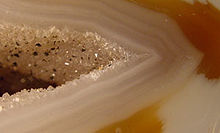| Revision as of 22:01, 17 October 2008 edit76.233.37.153 (talk) →Coloration← Previous edit | Revision as of 18:02, 19 October 2008 edit undoLaaknorBot (talk | contribs)122,478 editsm robot Adding: no:GeodeNext edit → | ||
| Line 45: | Line 45: | ||
| ] | ] | ||
| ] | ] | ||
| ] | |||
| ] | ] | ||
| ] | ] | ||
Revision as of 18:02, 19 October 2008
For other uses, see Geode (disambiguation).| This article relies largely or entirely on a single source. Relevant discussion may be found on the talk page. Please help improve this article by introducing citations to additional sources. Find sources: "Geode" – news · newspapers · books · scholar · JSTOR (October 2008) |




Geodes (Greek geoides, "earthlike") are geological rock formations which occur in sedimentary and certain volcanic rocks. Geodes are essentially rock cavities or vugs with internal crystal formations or concentric banding. The exterior of the most common geodes is generally limestone or a related rock, while the interior contains quartz crystals and/or chalcedony deposits. Other geodes are completely filled with crystal, being solid all the way through. These types of geodes are called nodules.
Formation
Geodes can form in any cavity, but the term is usually reserved for more or less rounded formations in igneous and sedimentary rocks, while the more general term "vug" is applied to cavities in fissures and veins. They can form in gas bubbles in igneous rocks, such as vesicles in basaltic lavas, or as in the American Midwest, rounded cavities in sedimentary formations. After rock surrounding the cavity hardens, dissolved silicates and/or carbonates are deposited on the inside surface. Over time, this slow feed of mineral constituents from groundwater or hydrothermal solutions allows crystals to form inside the hollow chamber. Bedrock containing geodes eventually weathers and decomposes, leaving them present at the surface if they are composed of resistant material such as quartz.
Coloration
The size of the crystals, including their form and shade of color, vary—making each geode unique. Some contain clear, pure quartz crystals, and others have rich purple amethyst crystals. Still others can have agate, chalcedony, or jasper or minerals such as calcite, dolomite, celestite, etc. There is no easy way of telling what the inside of a geode holds until it is cut open or broken apart, however, geodes from any one locality usually have a more restricted variety of interior mineralization.Some geodes can be as large as trees.
Geodes and geode slices are sometimes dyed with artificial colors. Samples of geodes with unusual colors or highly unlikely formations have usually been synthetically altered.
Prevalence
Geodes are common in some formations in the United States (mainly in Indiana, Iowa, Missouri, Kentucky and Utah). They also are common in Brazil, Namibia and Mexico. A large geode roughly the size of a minivan was discovered in Put-in-Bay, Ohio in the early 20th century. It is known as Crystal Cave, and tours are possible during the summer. In 1967, Iowa designated the geode as the official state rock, and it has a Geode State Park.
See also
Sources
- Rocks and Minerals, written by Fredrick H. Pough, ISBN 0-395-91096-X
External links
- Geode images, locations and discussion
- Australian Museum Fact sheet
- Utah Geode Beds
- Illinois State Geological Survey. "Geodes—Small Treasure Vaults in Illinois" (PDF).
{{cite news}}: Cite has empty unknown parameter:|coauthors=(help)